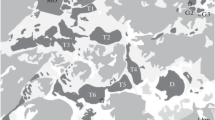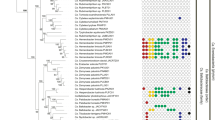Abstract
Five phylogenetically similar monocultures of mesophilic filamentous anoxygenic phototrophic bacteria (FAPB) were isolated from microbial mats of low-mineral (5–28 g/L) alkaline lakes in Buryat Republic, Transbaikalia and Mongolia, as well as from biofilms of an alkaline sulfide spring (3 g/L) of the Umhei hydrothermal system (Buryat Republic). New isolates were characterized by short trichomes (15–30 μm long and ∼1 μm in diameter), straight, curved, or wavy, surrounded by a thin iron-sorbing mucous sheath. Gliding motion of the trichomes was not observed. The trichomes formed bunches consisting of several filaments. Trichomes multiply by the separation of short fragments or single cells from the parental trichome. The cells in the filaments were elongated; they contained chlorosomes, gas vesicles, poly-β-hydroxybutyrate granules, and small polyphosphate inclusions. Bacteria contained bacteriochlorophylls c and a and γ-carotene. Absorption maxima of the pigments in the cells were observed at 462, (shoulder at 515), 742, 805, and 863 nm. The organisms were strict anaerobes capable of photoautotrophic growth with sulfide as an electron donor. Elemental sulfur emerged into the medium as a result of sulfide photooxidation. The organisms were tolerant to sulfide (up to 8 mM). Best growth occurred at pH 8.0, 3–15 g/L NaCl, and 1–5 g/L sodium bicarbonate. According to phylogenetic analysis, the 16S rRNA gene sequences of the FAPB isolates formed a separate cluster most closely related to the species cluster of the family Oscillochloridaceae, suborder Chloroflexinae, order Chloroflexales, class Chloroflexi. The differences with the closest 16S rRNA gene sequences of the known FAPB were 9–10%. The formal description of a new taxon, Candidatus’ Chloroploca asiatica’ gen. nov., sp. nov., is provided.
Similar content being viewed by others
References
Pierson, B.K. and Castenholz, R.W., A phototrophic, gliding filamentous bacterium of hot springs, Chloroflexus aurantiacus, gen. and sp. nov., Arch. Microbiol., 1974, vol. 100, pp. 5–24.
Pierson, B.K., Giovannoni, S.J., Stahl, D.A., and Castenholz, R.W., Heliothrix oregonensis, gen. nov., sp. nov., a phototrophic filamentous gliding bacterium containing bacteriochlorophyll a, Arch. Microbiol., 1985, vol. 142, pp. 164–167.
Hanada, S., Hiraishi, A., Shimada, K., and Matsuura, K., Chloroflexus aggregans sp. nov., a filamentous phototrophic bacterium which forms dense cell aggregates by active gliding movement, Int. J. Syst. Evol. Microbiol., 1995, vol. 45, no. 4, pp. 676–681.
Hanada, S., Takaichi, S., Matsuura, K., and Nakamura, K., Roseiflexus castenholzii gen. nov., sp. nov., a thermophilic, filamentous, photosynthetic bacterium that lacks chlorosomes, Int. J. Syst. Evol. Microbiol., 2002, vol. 52, pp. 187–193.
Keppen, O.I., Tourova, T.P., Kuznetsov, B.B., Ivanovsky, R.N., and Gorlenko, V.M., Proposal of Oscillochloridaceae fam. nov. on the basis of a phylogenetic analysis of the filamentous anoxygenic phototrophic bacteria, and emended description of Oscillochloris and Oscillochloris trichoides in comparison with further new isolates, Int. J. Syst. Evol. Microbiol., 2000, vol. 50, pp. 1529–1537.
Bryant, D.A., Liu, Z., Li, T., Zhao, F., Garcia Costas, A.M., Klatt, C.G., Ward, D.M., Frigaard, N.U., and Overmann, J., Comparative and functional genomics of anoxygenic green bacteria from the taxa Chlorobi, Chloroflexi and Acidobacteria in Advances in Photosynthesis and Respiration. Functional Genomics and Evolution of Photosynthetic Systems, Burnap, R.L. and Vermaas, W., Eds., Dordrecht: Springer, 2012, vol. 35, pp. 47–102.
Gupta, R.S., Chander, P., and George, S., Phylogenetic framework and molecular signatures for the class Chloroflexi and its different clades; proposal for division of the class Cloroflexia class. nov. [corrected] into the suborder Chloroflexineae subord. nov., consisting of the emended family Oscillochloridaceae and the family Chloroflexaceae fam. nov., and the suborder Roseiflexineae subord. nov., containing the family Roseiflexaceae fam. nov., Antonie van Leeuwenhoek, 2013, vol. 103, no. 1, pp. 99–119.
Gorlenko, V.M., Characteristics of filamentous phototrophic bacteria from freshwater lakes, Mikrobiologiya, 1975, vol. 44, no. 4, pp. 680–684.
Pivovarova, T.A. and Gorlenko, V.M., Fine stracture of Chloroflexus aurantiacus var. mesophilus (nom. prof.) grown in light under aerobic and anaerobic conditions, Mikrobiologiya, 1977, vol. 46, no. 2, pp. 329–334.
Dubinina, G.A. and Gorlenko, V.M., New filamentous photosynthetic green bacteria containing gas vacuoles, Mikrobiologiya, 1975, vol. 44, no. 3, pp. 452–458.
Gorlenko, V.M. and Pivovarova, T.A., On the belonging of bluegreen alga Oscillatoria coerulescens Gicklhorn, 1921 to a new genus of chlorobacteria Oscillochloris nov. gen., Izv. Akad. Nauk SSSR Ser. Biol., 1977, no. 3, pp. 396–409.
Gorlenko, V.M. and Korotkov, S.A., Morphological and physiological features of the new filamentous gliding green bacterium Oscillochloris trichoides nov. comb., Izv. Akad. Nauk SSSR Ser. Biol., 1979, no. 6, pp. 848–857.
Benaras, L., Gich, F., Martinez-Medina, M., Miller, M., Abella, C.A., and Borrego, C.M., New phylotype of mesophilic filamentous anoxygenic phototrophic bacteria enriched from sulfide-containing environments, Environ. Microbiol. Rep., 2009, vol. 1, no. 1, pp. 86–93.
Gorlenko, V.M., Puchkov, A.N., and Demchev, V.V., Photosynthetic microorganisms of the White Sea suporalittoral basins. Species composition, Biol. Nauki, 1985, no. 5, pp. 66–72.
Pierson, B.K., Valdez, D., Larsen, M., Morgan, E., and Mack, E.E., Chloroflexus-like organisms from marine and hypersaline environments: distribution and diversity, Photosynth. Res., 1994, vol. 41, pp. 35–52.
Kompantseva, E.I., Sorokin, D.Yu., Gorlenko, V.M., and Namsaraev, B.B., The phototrophic community found in lake Khilganta (an alkaline saline lake located in the Southeastern Transbaikal region), Microbiology (Moscow), 2005, vol. 74, no. 3, pp. 352–361.
Bachar, A., Omoregie, E., de Wit, R., and Jonkers, H.M., Diversity and function of Chloroflexus-like bacteria in a hypersaline microbial mat: phylogenetic characterization and impact on aerobic respiration, Appl. Environ. Microbiol., 2007, vol. 73, no. 12, pp. 3975–3983.
Nubel, U., Bateson, M.M., Madigan, M.T., Kuhl, M., and Ward, D.M., Diversity and distribution in hypersaline microbial mats of bacteria related to Chloroflexus spp., Appl. Environ. Microbiol., 2001, vol. 67, no. 9, pp. 4365–4371.
Klappenbach, J.A. and Pierson, B.K., Phylogenetic and physiological characterization of a filamentous anoxygenic photoautotrophic bacterium Candidatus’ Chlorothrix halophila’ gen. nov., sp. nov., recovered from hypersaline microbial mats, Arch. Microbiol., 2004, vol. 181, pp. 17–25.
Tourova, T.P., Spiridonova, E.M., Slobodova, N.V., Bulygina, E.S., Keppen, O.I., Kuznetsov, B.B., and Ivanovsky, R.N., Phylogeny of anoxygenic filamentous phototrophic bacteria of the family Oscillochloridaceae as inferred from comparative analyses of the rrs, cbbL and nifH genes, Microbiology (Moscow), 2006, vol. 75, no. 2, pp. 192–200.
Kuznetsov, B.B., Ivanovsky, R.N., Keppen, O.I., Sukhacheva, M.V., Bumazhkin, B.K., Patutina, E.O., Beletsky, A.V., Mardanov, A.V., Baslerov, R.V., Panteleeva, A.N., Kolganova, T.V., Ravin, N.V., and Skryabin, K.G., Draft genome sequence of the anoxygenic filamentous phototrophic bacterium Oscillochloris trichoides ssp. DG-6, J. Bacteriol., 2011, vol. 193, no. 1, pp. 321–322.
Hanada, S. and Pierson, B.K., The family Chloroflexaceae, in The Prokaryotes, 2006, vol. 7, Ch. 10.1, pp. 815–842.
Moskalenko, A.A. and Makhneva, Z.K., Light-harvesting complexes from purple sulfur bacteria Allochromatium minutissimum assembled without carotenoids, J. Photochem. Photobiol. B, 2012, vol. 108, no. 1, pp. 1–7.
Wilson, K., Preparation of genomic DNA from bacteria, in Current Protocols in Molecular Biology, 2001, 00:2.4.1–2.4.5.
Lane, D.J., 16S/23S rRNA sequencing, in Nucleic Acid Techniques in Bacterial Systematics, Stackebrandt, E. and Goodfellow, M., Eds., New York: Wiley, 1991, pp. 115–175.
Kalashnikov, A.M., Gaisin, V.A., Sukhacheva, M.V., Namsaraev, B.B., Panteleeva, A.N., Nuyanzina-Boldareva, E.N., Kuznetsov, B.B., and Gorlenko, V.M., Anoxygenic phototrophic bacteria from microbial communities of Goryachinsk thermal spring (Baikal area, Russia), Microbiology (Moscow), 2014, vol. 83, no. 4, pp. 388–402.
Gupta, R.S., Molecular signatures for the main phyla of photosynthetic bacteria and their subgroups, Photosynth. Res., 2010, vol. 104, pp. 357–372.
Hall, T.A., BioEdit: a user-friendly biological sequence alignment editor and analysis program for Windows 95/98/NT, Nucleic Acids Symp. Ser., 1999, no. 41, pp. 95–98.
Ashelford, K.E., Chuzhanova, N.A., Fry, J.C., Jones, A.J., and Weightman, A.J., At least one in twenty 16S rRNA sequence records currently held in public repositories estimated to contain substantial anomalies, Appl. Environ. Microbiol., 2005, vol. 12, pp. 7724–7736.
Tamura, K., Peterson, D., Peterson, N., Stecher, G., Nei, M., and Kumar, S., MEGA5: molecular evolutionary genetics analysis using maximum likelihood, evolutionary distance, and maximum parsimony methods, Mol. Biol. Evol., 2011, vol. 28, pp. 2731–2739.
Amann, R.I., Binder, B.J., Olson, R.J., Chisholm, S.W., Devereux, R., and Stahl, D.A., Combination of 16S rRNA-targeted oligonucleotide probes with flow cytometry for analyzing mixed microbial populations, Appl. Environ. Microbiol., 1990, vol. 56, pp. 1919–1925.
Olson, T.L., van de Meene, A.M., Francis, J.N., Pierson, B.K., and Blankenship, R.E., Pigment analysis of Candidatus ‘Chlorotrix halophile’ a green filamentous anoxigenic photototrophic bacterium, J. Bacteriol., 2007, vol. 189, no. 11, pp. 4187–4195.
Author information
Authors and Affiliations
Corresponding author
Rights and permissions
About this article
Cite this article
Gorlenko, V.M., Bryantseva, I.A., Kalashnikov, A.M. et al. Candidatus ‘Chloroploca asiatica’ gen. nov., sp. nov., a new mesophilic filamentous anoxygenic phototrophic bacterium. Microbiology 83, 838–848 (2014). https://doi.org/10.1134/S0026261714060083
Received:
Published:
Issue Date:
DOI: https://doi.org/10.1134/S0026261714060083




